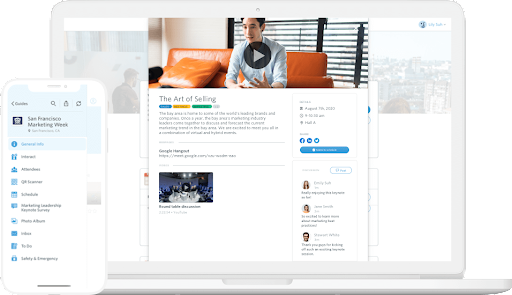
Utilizing Hybrid and Virtual Technology to Expand Your Event’s Reach
Virtual Events have existed before, but the growth since 2019 has been unprecedented. In 2020, The Bureau of Labor Statistics projected a growth in Meeting, Convention, and Event Planners at 9% by 2030. This year, that percentage more than doubled to 19%.
The last two years saw unprecedented growth in the utilization of technology to overcome the challenges of hosting virtual meetings to replace conferences that were traditionally in-person. Companies pivoted to build infrastructures around allowing thousands of attendees and exhibitors to meet virtually.
Although this unprecedented growth has been a challenge, virtual and hybrid technologies are allowing companies to expand their reach and grow their events in ways not seen 2 years ago.

Why should I keep or add a virtual component to my in-person event?
1. Virtual Components allow for more attendees and therefore more interaction
- Streaming sessions gives access anywhere
- Networking online and via mobile allows more users to connect
- Analytics from virtual attendees is more comprehensive
2. Virtual Components are more accessible
- Websites are more globally accessible
- Captioning and translators can assist in accessibility
- Mobile applications can tie into websites allowing for more connectivity
3. Hybrid Events allow you to connect your attendees more consistently.
- In-person app usage allows you to collect more data
- Attendees can connect with their virtual counterparts for expanded interactions
- Presenters can be either on-site or virtual
4. Streaming Events create a content library for later
- Content Libraries are lasting.
5. Sponsors and Exhibitors have more advertising opportunities.
Why should I keep or add a virtual component to my in-person event?
Starting in March of 2020, we saw an increase of clients that needed to move their in-person events to a streaming format. We were not the only company to adapt to this growing event sector. Companies like Zoom started expanding their offerings to support larger virtual events.
As we approach 2022, many organizations are evaluating whether they should maintain or add a virtual component to their event. In this article, we will review the reasons a virtual component is still relevant to conferences, meetings, symposiums, and other events.
The sudden shift to virtual events in the first half of 2020 produced mixed results in terms of attendance. While just over half of the events lost audience in the transition, 46% gained attendees as a result. Removing travel requirements and audience familiarity with video presentations worked together to keep event attendance largely intact.
Overall, about half of the attendees at these virtual events were neutral on their experience, more or less getting what they expected. But nearly a third indicated that they had a better experience than expected with some stating they had a better experience than an in-person event. (IDC).
Since this survey was assessed, there have been large improvements in accessibility that have increased attendance. In this article, we will share why a virtual component is still relevant for your next event.
Key takeaways
1. While there is a transition back to in-person events, virtual components allow more attendance.
2. By adding a hybrid component, you add value to your event.
Virtual Components allow for more attendees and therefore more interaction
Not everyone will be able to attend an in-person event. They should still have access to the value that your event gives. Additionally, additional attendees allows you to increase event revenue for your event.
While you are not able to create an identical experience to an in-person event, virtual components allow you to make your event more adaptable. For example, if you have a speaker that is no longer able to travel, you can have them join your conference virtually, and still maintain your schedule.
Streaming sessions gives access anywhere
One of the largest advances for virtual events has been streaming technology. Over the last 2 years we have streamed over 10,000,000 hours of content. Additionally, we have streamed content to 6 of 7 continents. Multiple events have reported record attendance due to the accessibility.
Networking online and via mobile allows more users to connect
Not all attendees will be able to attend in-person. We then have to connect in-person and virtual attendees. By adding discussions, chats, polls, and Q&A to your event, you are increasing engagements. Most attendees rated conferences more favorably when they felt they received more engagement from the event.
Analytics from virtual attendees is more comprehensive
When you host an in-person event, it’s hard to track who went to a specific session, who interacted with which exhibitor, among other key analytics. With virtual events, you are able to track who went to a specific event, and how long they stayed. This can be incredibly valuable for tracking continuing education credits.
Virtual Components are more accessible
Virtual events are more accessible. Not just to attend, but also for interactions. Streaming events allows you to have better access to translators, captioning, and other tools to increase accessibility.
Websites and streaming increase accessible attendance
Most attendees that have internet access can attend your event. You can increase attendance by connecting to people who are not able to travel to your event. Companies like Zoom started integrating the ability to have captions through companies like Rev.
Hybrid Events allow you to connect your attendees more consistently
In-person attendees can also benefit from a technology driven event. Before applications, like Guidebook, attendees would need a printed program book. There wasn’t a way to track specifics of who went to each session. Additionally, all interactions had to happen face to face.
While there is a lot to spontaneous conversations, structured conversations are also beneficial to the flow of your event. Websites and applications allow you to connect closer to your attendees, exhibitors, and sponsors.

In-person app usage allows you to collect more data
You will now be able to track metrics that you couldn’t with paper program books. By adding discussions, chats, polls, and Q&A in your application, you are able to consolidate responses and interaction tracking across your in-person and virtual attendees.
Attendees can connect with their virtual counterparts for expanded interactions
Previously, it was a decision between an in-person or virtual event. The main problem that had to be solved was connecting the two components to be more seamless. Both websites and applications have grown to include chats and discussions that are available to attendees, sponsors, and exhibitors. This allows seamless interactions between everyone, no matter their location.
Presenters can be either on-site or virtual
A few years ago a presenter who was sick two days before a conference would mean a canceled session. Now, presenters can join virtually. Now you don’t have to cancel that session, which may have been a highlight for your attendees.
Additionally, you can have hybrid panels that include both virtual and in-person speakers. This will allow for an increase in who can present at your conference. You no longer have to disqualify a session because the presenter is not able to attend in-person.
Streaming Events create a content library for later
One of the largest advantages of having a streaming component is that you are creating a lasting library of your sessions. While you may need to edit the content before posting, you can hire an A/V company, like our partner Bellwether, to post-product your content.
Content libraries are lasting
Having an archive of content is important to most organizations. Whether its for future education or for marketing purposes, having video of your sessions is a great way to expand your audience past your live event.
Push your data to your organization’s website
If you have an API integration for your website or AMS, you may be able to push your data back. This allows you to synchronize your data, such as videos, reports, and analytics.
Sponsors and Exhibitors have more advertising opportunities
Additional revenue streams can benefit your organization. With a website and/or application dedicated to your event, you are increasing advertising and marketing opportunities for your sponsors and exhibitors.
You can create packages that include sponsorship on the website and application. A website gives the option of advertisement sliders, logos in the footer, and sponsored sessions. Additionally, sponsors and exhibitors can have the option for push notifications and sponsored pages within the app.
Expanding Your Event’s Reach with Virtual Technology: Summary
While there is a rush to go back to in-person events, it’s worth a pause to consider adding or maintaining a virtual component to your event. Your organization will benefit from increased attendance, greater accessibility, increased sponsor revenue, and an archive of your event that users can access at a later date.
Virtual events went from being a solution to cancellations of in-person events. The technology produced in the last 2 years shows that having more connectivity and accessibility is important to attendees for most organizations.
